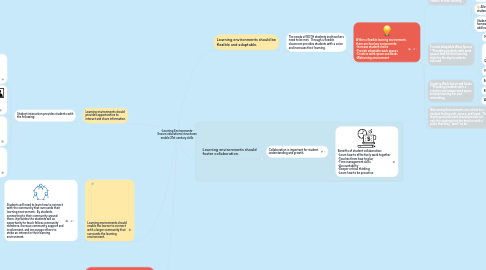
1. Learning environments should provides opportunities to interact and share information.
1.1. Student interaction provides students with the following:
1.1.1. Recognizing their thoughts
1.1.2. Reflect
1.1.3. Find gaps in their understanding
1.1.4. Improved social and interpersonal skills
2. Learning environments should enable the learner to connect with a larger community that surrounds the learning environment.
2.1. Students will need to learn how to connect with the community that surrounds their learning environment. By students connecting to their community around them, it provides the students will an opportunity to teach fellow community members, increase community support and involvement, and encourage others to strike an interest in their learning environment.
3. Through effective learning environments, students and teachers are able to practice 21st century skills.
4. Learning environments should be flexible and adaptable.
4.1. The needs of BOTH students and teachers need to be met. Through a flexible classroom provides students with a voice and increases their learning.
4.1.1. Within a flexible learning environment, there are four key components: -Increase student choice -Provide adaptable work spaces -Creative work space and desks -Welcoming environment
4.1.1.1. Increased Student Choice **Providing students with a choice in their education enables them to feel "in control"of their learning.
4.1.1.1.1. One effective way to give a student a choice in their learning is FLEXIBLE SEATING!
4.1.1.1.2. Allow students to choose materials.
4.1.1.1.3. Allow more opportunities for student-chosen projects.
4.1.1.1.4. Students get an option on their homework/assignments...such as due date, odd/even numbers, with a partner, etc.
4.1.1.2. Provide Adaptable Work Spaces **Providing students with work spaces that fit their learning style for the day in order to succeed.
4.1.1.2.1. Mobile Desk
4.1.1.2.2. Quiet areas
4.1.1.2.3. Mobile Chairs
4.1.1.3. Creative Work Space and Desks **Providing students with a creative and unique work space to keep learning fun and interesting.
4.1.1.3.1. Beanbag chairs
4.1.1.3.2. Reading nooks
4.1.1.3.3. Wobble Seats
4.1.1.4. Welcoming Environments are critical to a student feeling safe, secure, and loved. The learning environment should provide not only the students but the teacher with a place that they "want" to be.
5. Learning environments should foster collaboration.
5.1. Collaboration is important for student understanding and growth.
5.1.1. Benefits of student collaboration: -Learn how to effectively work together -Teaches them how to plan -Time management skills -Accountability -Deeper critical thinking -Learn how to be proactive

